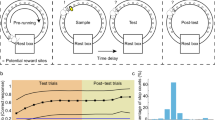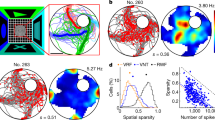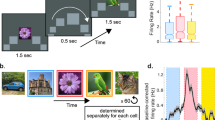Abstract
Temporal coding is a means of representing information by the time, as opposed to the rate, at which neurons fire. Evidence of temporal coding in the hippocampus comes from place cells, whose spike times relative to theta oscillations reflect a rat's position while running along stereotyped trajectories. This arises from the backwards shift in cell firing relative to local theta oscillations (phase precession). Here we demonstrate phase precession during place-field crossings in an open-field foraging task. This produced spike sequences in each theta cycle that disambiguate the rat's trajectory through two-dimensional space and can be used to predict movement direction. Furthermore, position and movement direction were maximally predicted from firing in the early and late portions of the theta cycle, respectively. This represents the first direct evidence of a combined representation of position, trajectory and heading in the hippocampus, organized on a fine temporal scale by theta oscillations.
This is a preview of subscription content, access via your institution
Access options
Subscribe to this journal
Receive 12 print issues and online access
$209.00 per year
only $17.42 per issue
Buy this article
- Purchase on Springer Link
- Instant access to full article PDF
Prices may be subject to local taxes which are calculated during checkout






Similar content being viewed by others
References
O'Keefe, J. & Nadel, L. The Hippocampus as a Cognitive Map (Oxford University Press, Oxford, 1978).
Wilson, M.A. & McNaughton, B.L. Dynamics of the hippocampal ensemble code for space. Science 261, 1055–1058 (1993).
Zhang, K., Ginzburg, I., McNaughton, B.L. & Sejnowski, T.J. Interpreting neuronal population activity by reconstruction: unified framework with application to hippocampal place cells. J. Neurophysiol. 79, 1017–1044 (1998).
Whishaw, I.Q. & Vanderwolf, C.H. Hippocampal EEG and behavior: effects of variation in body temperature and relation of EEG to vibrissae movement, swimming and shivering. Physiol. Behav. 6, 391–397 (1971).
O'Keefe, J. & Recce, M.L. Phase relationship between hippocampal place units and the EEG theta rhythm. Hippocampus 3, 317–330 (1993).
Skaggs, W.E., McNaughton, B.L., Wilson, M.A. & Barnes, C.A. Theta phase precession in hippocampal neuronal populations and the compression of temporal sequences. Hippocampus 6, 149–172 (1996).
Huxter, J., Burgess, N. & O'Keefe, J. Independent rate and temporal coding in hippocampal pyramidal cells. Nature 425, 828–832 (2003).
Geisler, C., Robbe, D., Zugaro, M., Sirota, A. & Buzsaki, G. Hippocampal place cell assemblies are speed-controlled oscillators. Proc. Natl. Acad. Sci. USA 104, 8149–8154 (2007).
Jensen, O. & Lisman, J.E. Position reconstruction from an ensemble of hippocampal place cells: contribution of theta phase coding. J. Neurophysiol. 83, 2602–2609 (2000).
Foster, D.J. & Wilson, M.A. Hippocampal theta sequences. Hippocampus 17, 1093–1099 (2007).
Dragoi, G. & Buzsaki, G. Temporal encoding of place sequences by hippocampal cell assemblies. Neuron 50, 145–157 (2006).
O'Keefe, J. & Burgess, N. Dual phase and rate coding in hippocampal place cells: theoretical significance and relationship to entorhinal grid cells. Hippocampus 15, 853–866 (2005).
Tsodyks, M.V., Skaggs, W.E., Sejnowski, T.J. & McNaughton, B.L. Population dynamics and theta rhythm phase precession of hippocampal place cell firing: a spiking neuron model. Hippocampus 6, 271–280 (1996).
Lisman, J.E. Relating hippocampal circuitry to function: recall of memory sequences by reciprocal dentate-CA3 interactions. Neuron 22, 233–242 (1999).
Hasselmo, M.E. What is the function of hippocampal theta rhythm? Linking behavioral data to phasic properties of field potential and unit recording data. Hippocampus 15, 936–949 (2005).
Siapas, A.G., Lubenov, E.V. & Wilson, M.A. Prefrontal phase locking to hippocampal theta oscillations. Neuron 46, 141–151 (2005).
Jones, M.W. & Wilson, M.A. Phase precession of medial prefrontal cortical activity relative to the hippocampal theta rhythm. Hippocampus 15, 867–873 (2005).
Harris, K.D. et al. Spike train dynamics predicts theta-related phase precession in hippocampal pyramidal cells. Nature 417, 738–741 (2002).
Jensen, O. & Lisman, J.E. Hippocampal CA3 region predicts memory sequences: accounting for the phase precession of place cells. Learn Mem. 3, 279–287 (1996).
Wallenstein, G.V. & Hasselmo, M.E. GABAergic modulation of hippocampal population activity: sequence learning, place-field development and the phase-precession effect. J. Neurophysiol. 78, 393–408 (1997).
Maurer, A.P., Cowen, S.L., Burke, S.N., Barnes, C.A. & McNaughton, B.L. Organization of hippocampal cell assemblies based on theta phase precession. Hippocampus 16, 785–794 (2006).
Buzsáki, G. Rhythms of the Brain (Oxford University Press, Oxford, 2006).
Muller, R.U. & Kubie, J.L. The firing of hippocampal place cells predicts the future position of freely moving rats. J. Neurosci. 9, 4101–4110 (1989).
Skaggs, W.E. & McNaughton, B.L. Replay of neuronal firing sequences in rat hippocampus during sleep following spatial experience. Science 271, 1870–1873 (1996).
Burgess, N., Recce, M. & O'Keefe, J. A model of hippocampal function. Neural Netw. 7, 1065–1081 (1994).
Harris, K.D., Csicsvari, J., Hirase, H., Dragoi, G. & Buzsaki, G. Organization of cell assemblies in the hippocampus. Nature 424, 552–556 (2003).
Mehta, M.R., Lee, A.K. & Wilson, M.A. Role of experience and oscillations in transforming a rate code into a temporal code. Nature 417, 741–746 (2002).
Yamaguchi, Y., Aota, Y., McNaughton, B.L. & Lipa, P. Bimodality of theta phase precession in hippocampal place cells in freely running rats. J. Neurophysiol. 87, 2629–2642 (2002).
Diba, K. & Buzsaki, G. Forward and reverse hippocampal place-cell sequences during ripples. Nat. Neurosci. 10, 1241–1242 (2007).
Greenstein, Y.J., Pavlides, C. & Winson, J. Long-term potentiation in the dentate gyrus is preferentially induced at theta rhythm periodicity. Brain Res. 438, 331–334 (1988).
Debanne, D., Gahwiler, B.H. & Thompson, S.M. Long-term synaptic plasticity between pairs of individual CA3 pyramidal cells in rat hippocampal slice cultures. J. Physiol. (Lond.) 507, 237–247 (1998).
Debanne, D., Guerineau, N.C., Gahwiler, B.H. & Thompson, S.M. Physiology and pharmacology of unitary synaptic connections between pairs of cells in areas CA3 and CA1 of rat hippocampal slice cultures. J. Neurophysiol. 73, 1282–1294 (1995).
Bi, G.Q. & Poo, M.M. Synaptic modifications in cultured hippocampal neurons: dependence on spike timing, synaptic strength and postsynaptic cell type. J. Neurosci. 18, 10464–10472 (1998).
Lisman, J.E., Talamini, L.M. & Raffone, A. Recall of memory sequences by interaction of the dentate and CA3: a revised model of the phase precession. Neural Netw. 18, 1191–1201 (2005).
McNaughton, B.L. et al. Deciphering the hippocampal polyglot: the hippocampus as a path integration system. J. Exp. Biol. 199, 173–185 (1996).
Samsonovich, A. & McNaughton, B.L. Path integration and cognitive mapping in a continuous attractor neural network model. J. Neurosci. 17, 5900–5920 (1997).
Taube, J.S., Muller, R.U. & Ranck, J.B. Jr. Head-direction cells recorded from the postsubiculum in freely moving rats. I. Description and quantitative analysis. J. Neurosci. 10, 420–435 (1990).
Sargolini, F. et al. Conjunctive representation of position, direction, and velocity in entorhinal cortex. Science 312, 758–762 (2006).
Golob, E.J. & Taube, J.S. Head direction cells in rats with hippocampal or overlying neocortical lesions: evidence for impaired angular path integration. J. Neurosci. 19, 7198–7211 (1999).
Maaswinkel, H., Jarrard, L.E. & Whishaw, I.Q. Hippocampectomized rats are impaired in homing by path integration. Hippocampus 9, 553–561 (1999).
Sharp, P.E. & Green, C. Spatial correlates of firing patterns of single cells in the subiculum of the freely moving rat. J. Neurosci. 14, 2339–2356 (1994).
Huerta, P.T. & Lisman, J.E. Bidirectional synaptic plasticity induced by a single burst during cholinergic theta oscillation in CA1 in vitro. Neuron 15, 1053–1063 (1995).
Ang, C.W., Carlson, G.C. & Coulter, D.A. Hippocampal CA1 circuitry dynamically gates direct cortical inputs preferentially at theta frequencies. J. Neurosci. 25, 9567–9580 (2005).
Muller, R.U., Kubie, J.L. & Saypoff, R. The hippocampus as a cognitive graph (abridged version). Hippocampus 1, 243–246 (1991).
Maurer, A.P. & McNaughton, B.L. Network and intrinsic cellular mechanisms underlying theta phase precession of hippocampal neurons. Trends Neurosci. 30, 325–333 (2007).
Lengyel, M., Szatmary, Z. & Erdi, P. Dynamically detuned oscillations account for the coupled rate and temporal code of place cell firing. Hippocampus 13, 700–714 (2003).
Giocomo, L.M., Zilli, E.A., Fransen, E. & Hasselmo, M.E. Temporal frequency of subthreshold oscillations scales with entorhinal grid cell field spacing. Science 315, 1719–1722 (2007).
Buzsaki, G. Theta oscillations in the hippocampus. Neuron 33, 325–340 (2002).
Magee, J.C. Dendritic mechanisms of phase precession in hippocampal CA1 pyramidal neurons. J. Neurophysiol. 86, 528–532 (2001).
Fisher, N.I. Statistical Analysis of Circular Data (Cambridge University Press, Cambridge, 1993).
Acknowledgements
Thanks to N. Campo-Urriza and L. Norman for technical assistance. We also thank J. Huck, T. Klausberger, P. Magill and O. Paulsen for providing helpful comments on the manuscript. This work was supported by the Medical Research Council (UK). The D.Phil. studentship of T.J.S. and K.A. are funded by the Wellcome Trust (UK).
Author information
Authors and Affiliations
Contributions
J.R.H., T.J.S. and K.A. conducted the experiments. J.R.H. carried out the data analyses. J.R.H. and J.C. wrote the manuscript. J.C. supervised the project.
Corresponding author
Supplementary information
Supplementary Text and Figures
Supplementary Figures 1–5 and Methods (PDF 777 kb)
Rights and permissions
About this article
Cite this article
Huxter, J., Senior, T., Allen, K. et al. Theta phase–specific codes for two-dimensional position, trajectory and heading in the hippocampus. Nat Neurosci 11, 587–594 (2008). https://doi.org/10.1038/nn.2106
Received:
Accepted:
Published:
Issue Date:
DOI: https://doi.org/10.1038/nn.2106
This article is cited by
-
The role of inhibitory circuits in hippocampal memory processing
Nature Reviews Neuroscience (2022)
-
Through synapses to spatial memory maps via a topological model
Scientific Reports (2019)
-
Prefrontal neuronal assemblies temporally control fear behaviour
Nature (2016)
-
Packet-based communication in the cortex
Nature Reviews Neuroscience (2015)
-
Impaired spatial selectivity and intact phase precession in two-dimensional virtual reality
Nature Neuroscience (2015)



